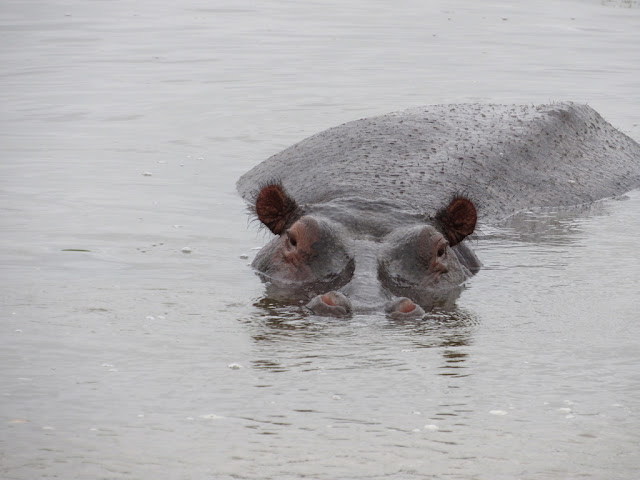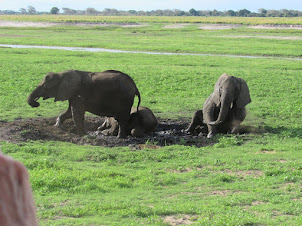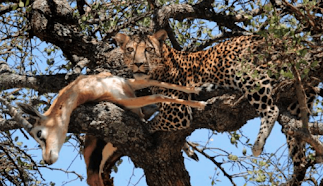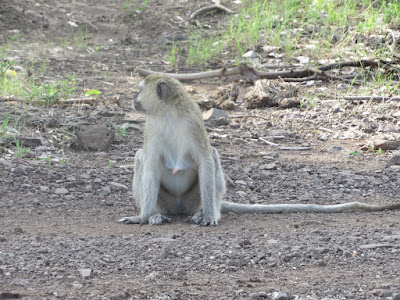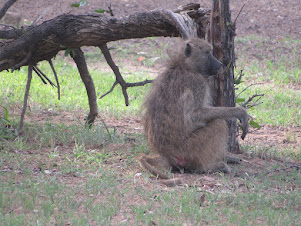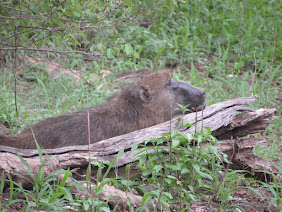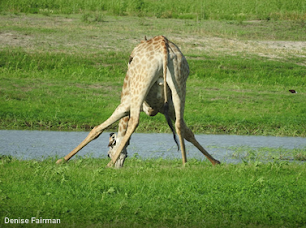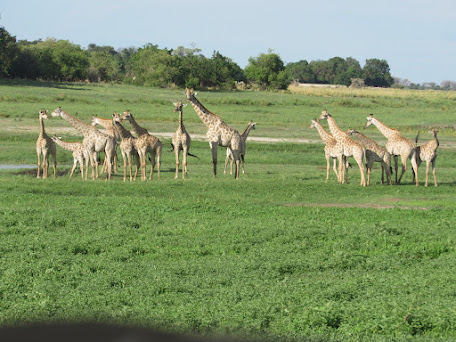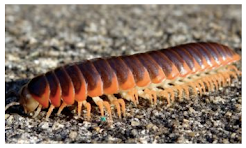During our 12-day safari we were able to get up close with an extraordinary number of animals thanks to our amazing local game drivers/trackers. We learned a bit about each animal and its interactions with other animals in their natural habitat. What a difference from going to the zoo where animals are cared for but contained! If kids could learn about animals on a safari, we would undoubtedly have more people interested in science, ecology, and preservation of the natural environment. As for me, better late than never.
Lions

After a few days of game drives, our group really wanted to see some lions. We got our wish on Christmas Eve when our trackers went off-road and took us on a bumpy ride over stones, tree trunks, and dung. Thanks to the trackers' driving skill and the durability and excellent suspension of our two jeeps, we saw our first pride of lions: a male, two females, and three cubs.
The female is the one who does the killing and the male is responsible for breeding the next generation. Lions are polygamous animals. A dominant male will mate with several females, but the pride sticks together for life. Once the male is no longer dominant, he is kicked out of the pride and is on his own.
Even though we were close to the lions, we were never in any danger. For one, the lions are used to the jeeps. Secondly, we were told that the animals see the jeep as a big entity that is stronger than they are, so they don't attack it. However, we were also cautioned not to be noisy, stand up, or make any sudden or big moves because that could excite the animal and cause it to either fight the vehicle or flee from it.
Here are some photos of lions taking it easy at a water hole.

Rhinoceros

Although we were told never to get out of the jeep while we were on a game drive, we were surprised when we went to the edge of Mosi-oa-Tunya National Park in Zambia and told to quietly get out of the jeep and form a line single file. We
were a little leery about what we were doing but by this time we trusted
our trip leader and guides, so we got out and walked. What we
saw was incredible: a group of huge white rhinos sleeping together (above).
our single file walk to the rhinos captured from MC's video of our safari
 We met the park rangers who carry AK-47s to protect the rhinos from poachers 24/7.
We met the park rangers who carry AK-47s to protect the rhinos from poachers 24/7.
Zambia once had a healthy population of several thousand black rhinos, but decades of poaching nearly wiped them out. In 2008, the Zambia Wildlife Authority successfully relocated four white rhinos from South Africa to Mosi-oa-Tunya, the traditional name for Victoria Falls (World Wildlife Magazine, Summer 2018). Currently, the park hosts ten white rhinos and we met them.
White rhinos got their name in order to differentiate them from black rhinos. However, they are hardly white. Their name was confused with the word "wide" to describe their large mouth. Nevertheless, black, white, or wide, rhinos are among the most dangerous animals in the bush. Their jaws can break an animal (or human) in half!
We took photos of ourselves with the rhinos. Here is one of my most treasured portraits--with the rhinos, thanks to MC's camera skills!
 All was well while the rhinos were sleeping. However, as they gradually rose to their feet one by one and started to move toward us, it seemed like a good time to leave carefully, quietly, and quickly.
All was well while the rhinos were sleeping. However, as they gradually rose to their feet one by one and started to move toward us, it seemed like a good time to leave carefully, quietly, and quickly.
As the rhinos walked they seemed to look like giant lawnmowers, given their square head that they keep close to the ground. Even so, none of us wanted to mess with them.
Before we left the rhinos, we saw another amazing sight: the mist from Victoria Falls. It truly lives up to its name: "the smoke that thunders".
Elephants
We
caught these elephants wallowing in the mud. However, once our jeep
stopped to look at them, the older elephant "told" the young ones to get
out of the mud. She was apparently miffed that we invaded a private
moment, and she stared us down.

Leopard
Sighting a leopard is very unusual because they are very shy, solitary animals. We saw this beautiful animal casually sitting under a tree. He was so beautiful! He noticed that we stopped to watch him, but after a couple minutes he got up and just walked away out of sight.

A few days before, we saw another leopard, a young adolescent male. As we crossed a bridge over a dry river bed, he happened to be passing under it frightened. He scampered away and into the bush. One of the members of our jeep saw him and cried "Jaguar! Jaguar!" However, this event occurred so quickly, we were unable to get our cameras ready. All we could see was a scraped paw print from his big claws. What excitement!
Leopards will take their lunch up a tree to eat it. I didn't take the photo on the right, but I got the remains of a leopard's repast (left).
Hippopotamus

Hippos spend a lot of time in the water because their skin is thin and sensitive to the sunlight. They can float in the water, which the babies frequently do, but hippos generally walk on the bottom of the river or stream. Their eyes and ears remain above water and occasionally they pop up their heads for air or to signal each other. Hippos communicate with each other at all times. If there is danger, one hippo in the pod will alert the group with a wide mouth and a yell.
A group of hippos is called a pod, and they tend to hang together. However, we did see one hippo who was alone with a very young baby.

Zebras
The zebra's characteristic stripes were beautiful and, of course, functional as camouflage.
The stripes on each zebra are unique.

Zebras are not dumb animals that get picked off easily by predators. In fact, they are very smart and very aware of their surroundings. And when they are attacked, they put up a big fight by kicking a predator with their hind legs and doing some serious damage to the attacker's internal organs.

Monkeys

Monkeys
are fun to watch because they do funny things and most like humans.
Care for their
babies is one aspect of their lives that is particularly interesting.
When the baby is just born, s/he hangs on to the mother from underneath
her. As it gets older, the baby rides on the mother's back.


Baboons
Baboons have been around for the past 2 million years, and there are six species that live primarily in southern Africa.
They are diurnal (sleep at night) and protect themselves from predators by staying in trees or on high cliffs or rocks at night. They are omnivorous. Their principal predators are crocodiles, leopards, lions, and hyenas.
Most baboons live in hierarchical troops containing harems. They communicate the hierarchical relations between each other with vocal exchanges.
Females are the primary caretakers of the young, but several females may share this responsibility for all of their offspring. Young baboons reach sexual maturity around five to eight years. Males leave their birth group before they reach sexual maturity while females stay in the same group for the rest of their lives. Baboons' lifespan is between 20 and 30 years.


Baboons are omnivorous foragers who will eat virtually anything, including our snacks at camp. Camp staff sometimes had to shoo them away from buffet tables.
They are foragers throughout the day
and night and often
break into homes and cars in search of food. They also raid
farms to eat crops and prey on sheep, goats, and poultry. We were told to keep the doors to our tents closed and barricaded to prevent baboons from entering.
Giraffes
This
was the first giraffe we saw -- a "young boy" alone in the bush. He
spotted us as well, and we stared at each other for a while. To see a giraffe loom over the trees is an awesome
sight, that is, when you can see them. Their camouflage hides them to protect them
from predators. Other animals will hang out with them because they can
see predators with their binocular vision. They can also see in color
and their senses of hearing and smell are sharp. Lions will attack them from the rear and because of
that, we saw a few giraffes who had lost their tails.

It
wasn't long after we saw the single male giraffe that we saw a tower of giraffes. Look at
how their necks cross! This is a classic pose. When the giraffes run
together, they are called a journey. And that's an amazing sight, too:
they lope. They are gorgeous creatures! Their long necks make them seem
so primitive. They turned out to be among our favorite animals.
The trackers pointed out that giraffes are among the few animals who walk by moving both legs on one side of the body, then doing the same on the other side.
Younger males form “bachelor herds” after leaving their mothers and usually follow older males to learn from them. Older males either live alone, with females, or in pairs. Male giraffes don’t form tight bonds with others like the females do but instead have “acquaintances”.
Their horns are called
ossicones. They are formed from ossified cartilage, covered in skin and
fused to the skull. The ossicones may have a role in thermoregulation,
and are used in combat between males. You can tell the difference
between males and females by the shape of the ossicones. The male's
ossicone is V-shaped and hairless while the female's is U-shaped and
hairy.
On one of our last days in the bush we saw these two giraffes mating. Males make a loud coughing noise during courtship.

Seeing
a giraffe drink or eat grass on the ground is to witness some mighty
flexibility. Here are two angles. I caught the giraffe drinking (left)
and Denise Fairman of our safari group captured the giraffe eating grass
(right).


Here's a great photo by Karen Dumchus, one of the members of our safari. How did she get them to line up like this??
Here are some giraffe bones, which reminded me of Georgia O'Keefe's skeletal paintings of desert bones in the American Southwest. It was interesting that we saw a lot of animal dung on the land, but not many bones. Hyenas eat the bones and sometimes toss them about. As the sun scorches them, they break down and become part of the ground. This process, however, takes years to occur.

Antelopes
Antelopes are everywhere! They like arid savanna lands and the areas we visited in Botswana, Zambia, and Zimbabwe are the right places for them. Africa has 78 varieties of antelope across the continent; we saw several different types in our safari areas. How beautiful they are!
Impalas were the most common antelopes in the bush, and fun to watch because of their speed and gracefulness.
I was unable to capture the leaping impalas; they move so fast. So I relied on the Internet. These animals seem to enjoy life in the bush the most as they run with a lilt. No wonder Chevrolet named one of their flagship passenger cars after them.
We were there at just the right moment to see these young male impalas jousting.

We saw a few other species
of antelope during our two weeks in the bush. Their size, horns, and markings distinguished them from each other.
My favorite was the black sable antelope. It has the darkest coat and long ringed horns that arch backwards (24–40 inches for females and 32–65 inches for males). Their average lifespan in the wild is 19 years.
Sable antelope are grazers and browsers. They are prey for carnivores. When they are threatened by predators they fight back aggressively by using their horns to reach back toward their rump where predators tend to attack them.
The sable antelope lives in herds of 10 to 30 females and calves led by a single male bull. Males fight among themselves to lead the herd by dropping to their knees
and using their horns although they don't wound any of their contenders. When young males reach 3 years old they are exiled from the herd to form "bachelor groups" of up to 12. The most
dominant one is the first to join a new group of females that has been formed with the herd gets too large and splits up.
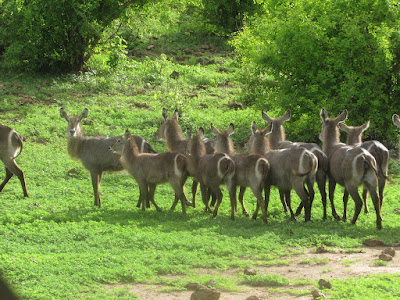 Waterbucks have a circular target on their rumps. Their shaggy coats become darker with age, and males are darker than females. When sexually excited, the waterbuck's skin secretes a greasy substance with the odor of musk that is so unpleasant, it repels predators. This secretion also water-proofs them when they go into water.
Waterbucks have a circular target on their rumps. Their shaggy coats become darker with age, and males are darker than females. When sexually excited, the waterbuck's skin secretes a greasy substance with the odor of musk that is so unpleasant, it repels predators. This secretion also water-proofs them when they go into water.
The waterbuck lives in herds of six to 30. When young males start developing horns (around seven to nine months of age), they are chased out of the herd by territorial bulls and form bachelor herds. A few females may form spinster herds.
Males show territorial behavior between 5 to 9 years old. They generally remain settled in their territories until they move to more spacious ones. After age ten, males lose their territorial nature and are replaced by a younger bull; the oldsters recede to small and unprotected areas.
Satellite males, another social group, consist of mature bulls without their own territories. They exploit mating opportunities and contribute to the group's defense even in the presence of a dominant male. However, they may gradually deprive the dominant male of his territory and seize the area for themselves. In a study in the Lake Nakuru National Park, only 7 percent of the adult males held territories, and only half of the territorial males tolerated one or more satellite males.
 Territorial males may use several kinds of display to communicate and frighten trespassers like exposing the white patch on the throat and between the
eyes and to flaunt the thickness of the neck. To show submission to a territorial male who stands erect, the inferior waterbuck lowers his head and body. Fights between waterbucks may last up to thirty minutes. They involve snorting and/or a flehmen response (curling back the upper lip and exposing the front teeth while inhaling with the nostrils closed for
several seconds).
Territorial males may use several kinds of display to communicate and frighten trespassers like exposing the white patch on the throat and between the
eyes and to flaunt the thickness of the neck. To show submission to a territorial male who stands erect, the inferior waterbuck lowers his head and body. Fights between waterbucks may last up to thirty minutes. They involve snorting and/or a flehmen response (curling back the upper lip and exposing the front teeth while inhaling with the nostrils closed for
several seconds).
Waterbucks often dive into water to escape their predators even though they do not particularly like being in water. Waterbucks may also run into cover when alarmed, although males often attack predators.
The majestic kudu distinguishes itself from other antelopes with its twisted horns and thin stripes on its body. While female kudus have short horns, male kudus grow horns up to 70 inches long, which take about six years
We only saw one steenbok and it was so small, it was almost hidden in the long grasses.
The steenbok is widely adored all over the world due to its small size and little pencil-like horns that stand straight up. They are very fast for their size and very hard for many predators to catch.
They are active during the day and the night, however, during hotter periods, they rest under shade. While they rest, they may groom, ruminate or taking brief naps.
At the first sign of trouble, steenbok typically lie low in the vegetation. If a predator or perceived threat comes closer, a steenbok will leap away and follow a zigzag route to try to shake off the pursuer. They sometimes take refuge in the burrows of aardvarks. Their predators include Southern African wildcat, caracal, jackals, leopard, martial eagle and pythons.
Below are antelope horns left over after a kill or a natural death.

Cape Buffalo
Caught wallowing in the mud, the Cape buffalo stares us down. We didn't see many of them and only one herd.
 They seem given to staring a lot, more so than other animals. What could they be thinking?? They are very dangerous animals and thus were named to the Big Five as highly sought-after
hunting trophies. Fortunately, we were safely seated in the jeep and out of harm's way. They have unpredictable tempers and were never domesticated like their relative, the Asian water buffalo.
They seem given to staring a lot, more so than other animals. What could they be thinking?? They are very dangerous animals and thus were named to the Big Five as highly sought-after
hunting trophies. Fortunately, we were safely seated in the jeep and out of harm's way. They have unpredictable tempers and were never domesticated like their relative, the Asian water buffalo. The most unmistakable feature of the Cape buffalo is its majestic set of horns. Called a “boss”, the bases of a male buffalo’s horns come together to form a shield. At five or six, the horns might be fully formed, however, it is only after a couple more years that the boss becomes completely hard and perfect for sparring.
Below, the buffaloes seem content to be "home on the range" and not bothered by anyone--either predators or jeeps of nosey safari people.
Buffalo bone left-overs
Jackals
They look like dogs, and they are from the canine family, but jackals are wild predators and scavengers of small mammals, birds, and reptiles. Their physique allows them to do a lot of long-distance running. As crepuscular animals, they are most active at dawn and dusk, so we were lucky to see them in midday.
They are monogamous animals who have territories large enough to support some young adults until they are ready to leave their parents and establish their own territories. They usually hunt alone or in pairs, but sometimes they form small packs to scavenge a carcass.

Like foxes
and coyotes, jackals are often depicted as clever sorcerers in the myths
and legends of their regions. They are frequently used as a literary device to illustrate desolation,
loneliness, and abandonment, with reference to their habit of living in
the ruins of former cities and other areas abandoned by humans.
Warthogs
hey are largely herbivorous, they occasionally also eat small animals.
Warthogs are generally passive, mellow animals not looking for trouble. They seek out abandoned dens made by aardvarks and make them their homes. When they are threatened, they retreat to these dens and enter them rear end first so their big tusks stick out of the entrance for extra protection.
Female warthogs, called sows, are social animals and live in groups
called sounders, which can contain up to 40 members, according to the
San Diego Zoo. Females groom each other and huddle together at night for
warmth. Adult males aren't as social and can be territorial. Often,
they live alone.
Warthogs forage during dawn and twilight hours or at night if they live in a dangerous area. Birds like to ride on warthogs to eat insects off their backs. Warthogs like to wallow in mud to get rid of insects and to cool down on a hot day. Like pigs, warthogs don't have sweat glands to cool themselves. The padding on their knees allows them to kneel and eat grasses or to slurp up a bug.
Last but not least are some reptiles and a unique insect we encountered.

leopard turtle
another lizard I found near my tent
Millipod (about "1,000" legs under him) and very near our jeep. Afterward, when I saw one on the way to my tent, I was not afraid.
Sources
https://safarisafricana.com/african-antelopes/
https://en.wikipedia.org/wiki/Sable_antelope
https://en.wikipedia.org/wiki/Waterbuck
https://en.wikipedia.org/wiki/Baboon
https://www.nationalgeographic.com/animals/mammals/facts/hippopotamus
https://en.wikipedia.org/wiki/Jackal
https://www.livescience.com/58337-warthog-facts.html
